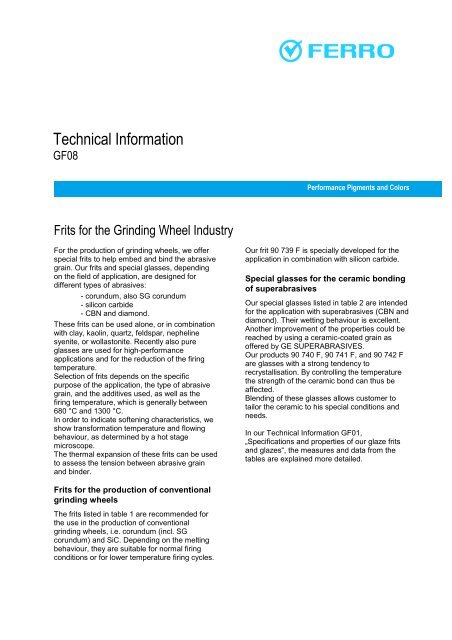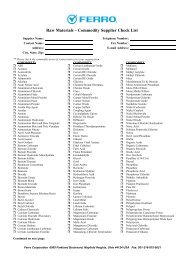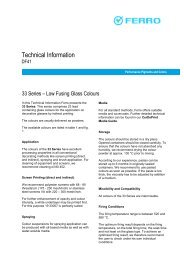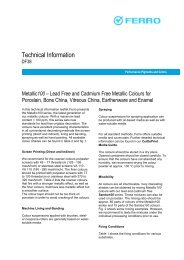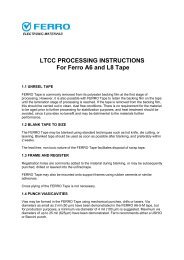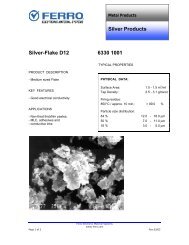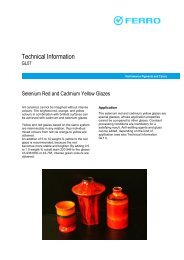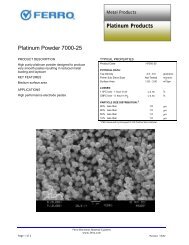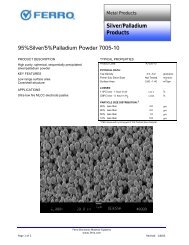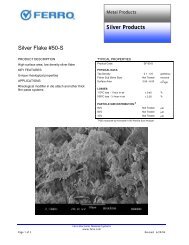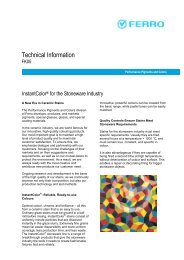Frits for the Grinding Wheel Industry - Ferro
Frits for the Grinding Wheel Industry - Ferro
Frits for the Grinding Wheel Industry - Ferro
You also want an ePaper? Increase the reach of your titles
YUMPU automatically turns print PDFs into web optimized ePapers that Google loves.
Technical In<strong>for</strong>mation<br />
GF08<br />
<strong>Frits</strong> <strong>for</strong> <strong>the</strong> <strong>Grinding</strong> <strong>Wheel</strong> <strong>Industry</strong><br />
For <strong>the</strong> production of grinding wheels, we offer<br />
special frits to help embed and bind <strong>the</strong> abrasive<br />
grain. Our frits and special glasses, depending<br />
on <strong>the</strong> field of application, are designed <strong>for</strong><br />
different types of abrasives:<br />
- corundum, also SG corundum<br />
- silicon carbide<br />
- CBN and diamond.<br />
These frits can be used alone, or in combination<br />
with clay, kaolin, quartz, feldspar, nepheline<br />
syenite, or wollastonite. Recently also pure<br />
glasses are used <strong>for</strong> high-per<strong>for</strong>mance<br />
applications and <strong>for</strong> <strong>the</strong> reduction of <strong>the</strong> firing<br />
temperature.<br />
Selection of frits depends on <strong>the</strong> specific<br />
purpose of <strong>the</strong> application, <strong>the</strong> type of abrasive<br />
grain, and <strong>the</strong> additives used, as well as <strong>the</strong><br />
firing temperature, which is generally between<br />
680 °C and 1300 °C.<br />
In order to indicate softening characteristics, we<br />
show trans<strong>for</strong>mation temperature and flowing<br />
behaviour, as determined by a hot stage<br />
microscope.<br />
The <strong>the</strong>rmal expansion of <strong>the</strong>se frits can be used<br />
to assess <strong>the</strong> tension between abrasive grain<br />
and binder.<br />
<strong>Frits</strong> <strong>for</strong> <strong>the</strong> production of conventional<br />
grinding wheels<br />
The frits listed in table 1 are recommended <strong>for</strong><br />
<strong>the</strong> use in <strong>the</strong> production of conventional<br />
grinding wheels, i.e. corundum (incl. SG<br />
corundum) and SiC. Depending on <strong>the</strong> melting<br />
behaviour, <strong>the</strong>y are suitable <strong>for</strong> normal firing<br />
conditions or <strong>for</strong> lower temperature firing cycles.<br />
Per<strong>for</strong>mance Pigments and Colors<br />
Our frit 90 739 F is specially developed <strong>for</strong> <strong>the</strong><br />
application in combination with silicon carbide.<br />
Special glasses <strong>for</strong> <strong>the</strong> ceramic bonding<br />
of superabrasives<br />
Our special glasses listed in table 2 are intended<br />
<strong>for</strong> <strong>the</strong> application with superabrasives (CBN and<br />
diamond). Their wetting behaviour is excellent.<br />
Ano<strong>the</strong>r improvement of <strong>the</strong> properties could be<br />
reached by using a ceramic-coated grain as<br />
offered by GE SUPERABRASIVES.<br />
Our products 90 740 F, 90 741 F, and 90 742 F<br />
are glasses with a strong tendency to<br />
recrystallisation. By controlling <strong>the</strong> temperature<br />
<strong>the</strong> strength of <strong>the</strong> ceramic bond can thus be<br />
affected.<br />
Blending of <strong>the</strong>se glasses allows customer to<br />
tailor <strong>the</strong> ceramic to his special conditions and<br />
needs.<br />
In our Technical In<strong>for</strong>mation GF01,<br />
„Specifications and properties of our glaze frits<br />
and glazes“, <strong>the</strong> measures and data from <strong>the</strong><br />
tables are explained more detailed.
page 2/2 GF08 11/12<br />
Table 1 <strong>Frits</strong> <strong>for</strong> <strong>the</strong> production of conventional grinding wheels<br />
Product number Density C.T.E.<br />
Softening<br />
behaviour<br />
(20-400°C) Tg BS HBT<br />
90 158 M<br />
90 158 F<br />
90 158 E<br />
90 167 M<br />
90 167 F<br />
90 263 M<br />
90 263 F<br />
PPCISGF0811/12E<br />
<strong>Ferro</strong> GmbH Per<strong>for</strong>mance Pigments and Colors Gutleutstr. 215 60327 Frankfurt/M.<br />
Tel. ++49/69/27116-432 Fax ++49/69/27116-243, e-mail: pigments@ferro.com<br />
Composition Application<br />
g/cm 3 x 10 -7 / K °C °C °C Li2O Na2O K2O B2O3 Al2O3 CaO MgO BaO ZnO SiO2<br />
2.4 87 519 660 750 B A A Corundum<br />
2.5 152 465 660 750 B B B B C A Corundum<br />
2.5 129 442 570 710 B B A B B B A Corundum<br />
90 328 F 2.2 49 495 795 1270 B A B A Corundum, SiC<br />
90 404 F 2.5 62 540 750 920 B B B C C A Corundum, SiC<br />
90 5735 F 2.6 96 490 580 680 C B B A A Corundum<br />
90-3706909 (M) 2.8 105 490 620 720 C B C B C B B A Corundum<br />
90 739 F 2.7 57 710 920 1160 B B C B A SiC<br />
A= >20%, B= 5-20%, C= 20%, B= 5-20%, C=


